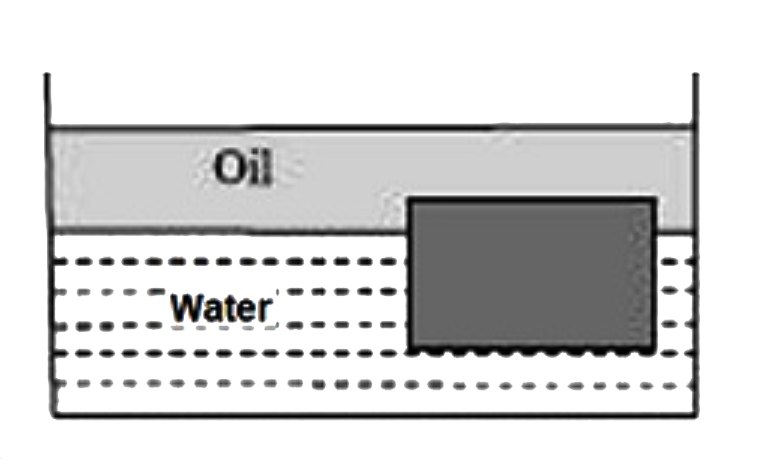In Fig , a block of density ρ=800kg/m3 floats face down in a fluid of density ρf=1200kg/m3 . The block has height H = 6.0 m
(a) By what depth h is the block submerged ?

(b) If the block is held fully submerged and then released , what is the magnitude of its acceleration ?
From Eq. , we know that the buoyant force has the magnitude Fb=mfg , where mf is the mass of the fluid displaced by the block.s submerged volume Vf , From Eq. (ρ=m/V) , we know that the mass of the displaced fluid is mf=ρfVf , We do not know Vf but if we symbolize the block.s face length as L and its width as W , then from Fig . we see that the submerged volume must be Vf=LWh . If we now combine our three expressions , we find that the upward buoyant force has magnitude
Fb=mfg=ρfVfg=ρfLWhg.
Similarly , we can write the magnitude Fg of the gravitational force on the block , first in terms of the block.s mass m , then in terms of the block.s density ρ and (full) volume V , and then in terms of the block.s dimensions L , W , and H (the full height) :
Fg=mg=ρVg=ρLWHg
The floating block is stationary . Thus , writing Newton.s second law for components along a vertical y axis with the positive direction upward (Fnet,y=may) , we have Fb−Fg=m(0) ,
or from Eqs. 14-20 and 14-21,
ρfLWhg−ρLWHg=0, which gives us
h=ρρfH=800Kg/m31200kg/m3(6.0cm)
=4.0 cm
(b) The gravitational force on the block is the same but now , with the block fully submerged , the volume- of the displaced water is V = LWH . (The full height of the block is used . ) This means that the value of Fb is now larger , and the block will no longer be stationary but will accelerate upward . Now , Newton.s second law yields Fb−Fg=ma ,
or ρfLWHg−ρLWHg=ρLWHa, where we inserted ρLWH for the mass m of the block .
Solving for a leads to
a=(ρfρ−1)g=(1200kg/m3800kg/m3−1)(9.8m/s2)
=4.9m/s2
Topper's Solved these Questions
- BOOK - RESNICK AND HALLIDAYCHAPTER - FLUIDSEXERCISE - SAMPLE PROBLEM 14.051videos
FLUIDS
- BOOK - RESNICK AND HALLIDAYCHAPTER - FLUIDSEXERCISE - SAMPLE PROBLEM 14.061videos
FLUIDS
- BOOK - RESNICK AND HALLIDAYCHAPTER - FLUIDSEXERCISE - SAMPLE PROBLEM 14.031videos
FLUIDS
- BOOK - RESNICK AND HALLIDAYCHAPTER - ELECTROMAGNETIC WAVES EXERCISE - PRACTICE QUESTIONS (Integer Type)3videos
ELECTROMAGNETIC WAVES
- BOOK - RESNICK AND HALLIDAYCHAPTER - FORCE AND MOTION - I EXERCISE - PRACTICE QUESTIONS (Integer Type)3videos
FORCE AND MOTION - I
Similar Questions
In Fig. , a rectangular block floats in a liquid . A block of mass m = 0.500 kg and density ρ=700kg/m3 floats face down in a liquid of density ρf=1200kg/m3 . What are the magnitude of the buoyant force on the block from the liquid , the weight of the liquid displaced by the block (liquid that would be in the space now occupied by the block ) , and the mass of that displaced liquid ? What fraction of the block's volume is submerged ? What fraction of its height is submerged ?
 View Solution
View SolutionA wood block (mass 3.67 kg, density 600 kg/m) is fitted with lead (density 1.14×104kg/m3) so that it floats in water with 0.700 of its volume submerged. Find the lead mass if the lead is fitted to the block's (a) top and (b) bottom
View Solution
Knowledge Check
- Question 1 - Select One
A block of mass 5 kg and volume 0.05m3 floats in a liquid of density 140kg m−3 .
The fraction of block inside liquid isA75B27C57D72 - Question 2 - Select One
A block of mass 5 kg and volume 0.05m3 floats in a liquid of density 140kg m−3 .
Fraction of block outside liquid isA27B72C37D73 - Question 3 - Select One
If the density of a block is 981 kg/m3 then it shall
Asink in waterBfloat with some part emmersed in waterCfloat completely immersed in waterDfloat completely out of water
A block of mass 5 kg and volume 0.05m3 floats in a liquid of density 140kg m−3 .
Volume of block above the surface of liquid isView SolutionA rectangular block of wood of density 800kgm−3 having a mass of 2 kg is pushed in to water so that it is completely submerged and then released. Neglecting viscous forces, the initial acceleration of the block will be (g=10ms2)
View SolutionA layer of oil with density 724 kg m−3 floats on water of density 1000kgm−3. A block floats on the oil-water interface with 1/6 of its volume in oil and 5/6 of its volume in water, as shown in the figure. What is the density of the block?
 View Solution
View SolutionA wooden block of density 860kg/m3 at 0∘C is floating on bezene liquid of density 900kgm3 at 0∘C. The temperature at which the block just submerge in benzene is
[γwood=8×10−5/∘c,γbenzene=12×10−4/∘c]View SolutionA block of wood floats with 1//4 of its volume under water. What is he density of wood? (Density of water =1000kg/m3)
View Solution

